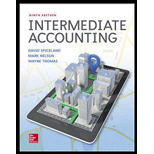
Concept explainers
Net gain
• LO17–6
The projected benefit obligation and plan assets were $80 million and $100 million, respectively, at the beginning of the year. Due primarily to favorable stock market performance in recent years, there also was a net gain of $30 million. On average, employees’ remaining service life with the company is 10 years. As a result of the net gain, what was the increase or decrease in pension expense for the year?
Want to see the full answer?
Check out a sample textbook solution
Chapter 17 Solutions
INTERMEDIATE ACCOUNTING (LL) W/CONNECT
Additional Business Textbook Solutions
Horngren's Accounting (12th Edition)
Financial Accounting, Student Value Edition (5th Edition)
Principles of Operations Management: Sustainability and Supply Chain Management (10th Edition)
Operations Management: Processes and Supply Chains (12th Edition) (What's New in Operations Management)
Essentials of MIS (13th Edition)
Intermediate Accounting (2nd Edition)
 Individual Income TaxesAccountingISBN:9780357109731Author:HoffmanPublisher:CENGAGE LEARNING - CONSIGNMENT
Individual Income TaxesAccountingISBN:9780357109731Author:HoffmanPublisher:CENGAGE LEARNING - CONSIGNMENT Cornerstones of Cost Management (Cornerstones Ser...AccountingISBN:9781305970663Author:Don R. Hansen, Maryanne M. MowenPublisher:Cengage Learning
Cornerstones of Cost Management (Cornerstones Ser...AccountingISBN:9781305970663Author:Don R. Hansen, Maryanne M. MowenPublisher:Cengage Learning

